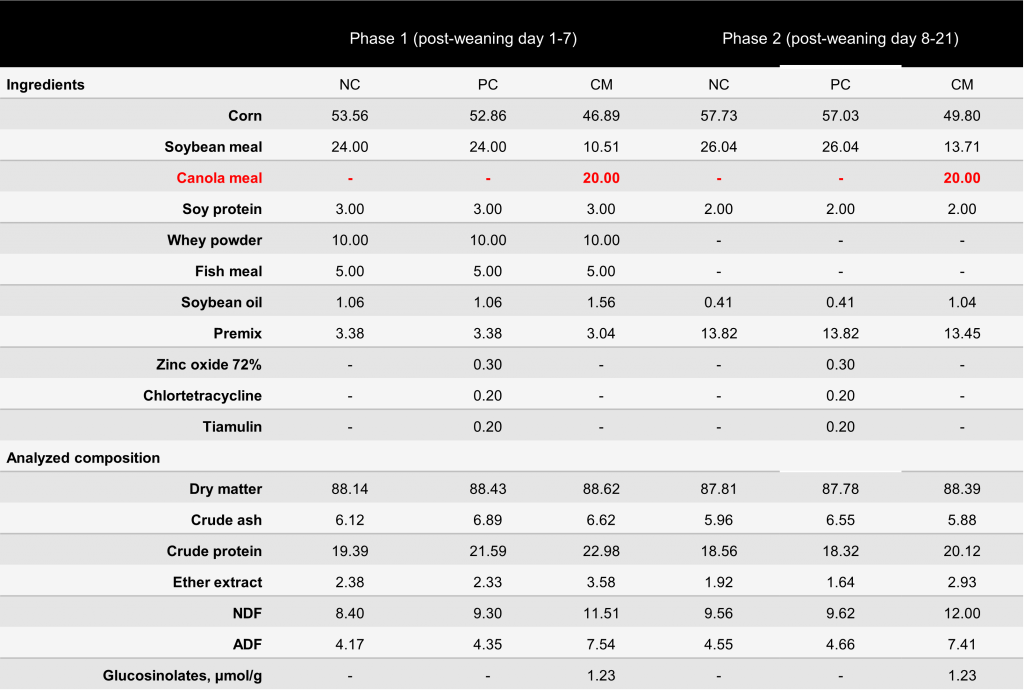

December 2021
Journal of Animal Science, Volume 99, Issue 8, August 2021, skab196
Reviewed by Dr. Charles (Gouqing) Qin
Canola meal, along with rapeseed meal, is the second most traded protein source worldwide. Canola meal is recognized for its well-balanced amino acids profile and very low levels of glucosinolates. The major limitation to the use of canola meal in diets for swine is its fiber, which is higher than that found in soybean meal. However, this has been shown to be less problematic when diets are formulated on Net Energy (NE) and Standardized Ileal Digestibility of amino acids (SID). In fact, recent studies observed excellent growth performance in weaned pigs with dietary level of canola meal at 20% (Landero et al., 2011), 30% (Mejicanos et al., 2016) or 40% (Parr et al., 2015; Hong et al., 2020). Excellent growth performance was observed in nursery pigs with dietary levels of canola meal from 0-40% (Hong et al., 2020).
This study was conducted to determine if canola meal impacted gut health in very sensitive nursery pigs. Non-starch polysaccharides of canola meal may affect the net absorption of fluid and solutes by E. coli-challenged pigs (Kiarie et al., 2008). If so, that would be a benefit to nursery pigs raised under commercial conditions and exposed to enterotoxigenic E. coli challenge.
The composition of the diets is shown in Table 1. The negative control (NC) diet was a typical corn-soy diet, while the positive control diet provided zinc oxide, Chlortetracycline and Tiamulin. All three diets were formulated to the same NE and SID amino acid levels.
When compared to the NC diet, the CM treatment increased (p<0.05) overall average daily gain and feed intake by 22% and 23%, respectively, while the PC treatment increased (p<0.05) overall ADG and ADFI compared by 48% and 47%, respectively. These results are shown graphically in Figure 1. The improvement over the negative control was surprising and exceeded expectations.

Figure 1. Nursery pigs’ growth and efficiency pre and post challenged with E. coli
Fecal score was improved (P<0.05) before and after the E. coli challenge when the pigs were given the PC diet enriched with antibiotics relative to the NC. Although scores were numerically lower with the CM treatment, the differences failed to reach significance.
Both the CM and PC diets increased (P<0.05) the pH of ileal digesta, although the CM treatment did not affect the pH of cecal digesta or colonic digesta (Figure 2). The cecal and colonic pH for CM-containing diet was less (P<0.05) than that of PC antibiotics-containing diet.
On day 20 of the trial, cecal contents were evaluated for volatile fatty acids (VFA). The PC control diet reduced total VFA by 61%, and the CM treatment reduced VFA by 30% relative to the NC treatment.
The test strain of E. coli was not detected in the feces of pigs prior to conducting the challenge study. Interestingly, the E. coli strain was found in the feces on day 7 and day 14 of the challenge, with no differences between the any of the dietary treatments imposed.
With the need to reduce the use of antibiotics in livestock feeding, these results indicate that canola meal can be a means to supporting the health and productivity of weaned piglets. Relative to the NC treatment, the CM treatment improved growth performance and gut health. While canola meal is not a replacement for antibiotics in a major outbreak, it can be a beneficial adjunct to assist in alleviating the stress on the gut under normal feeding circumstances.